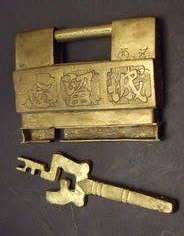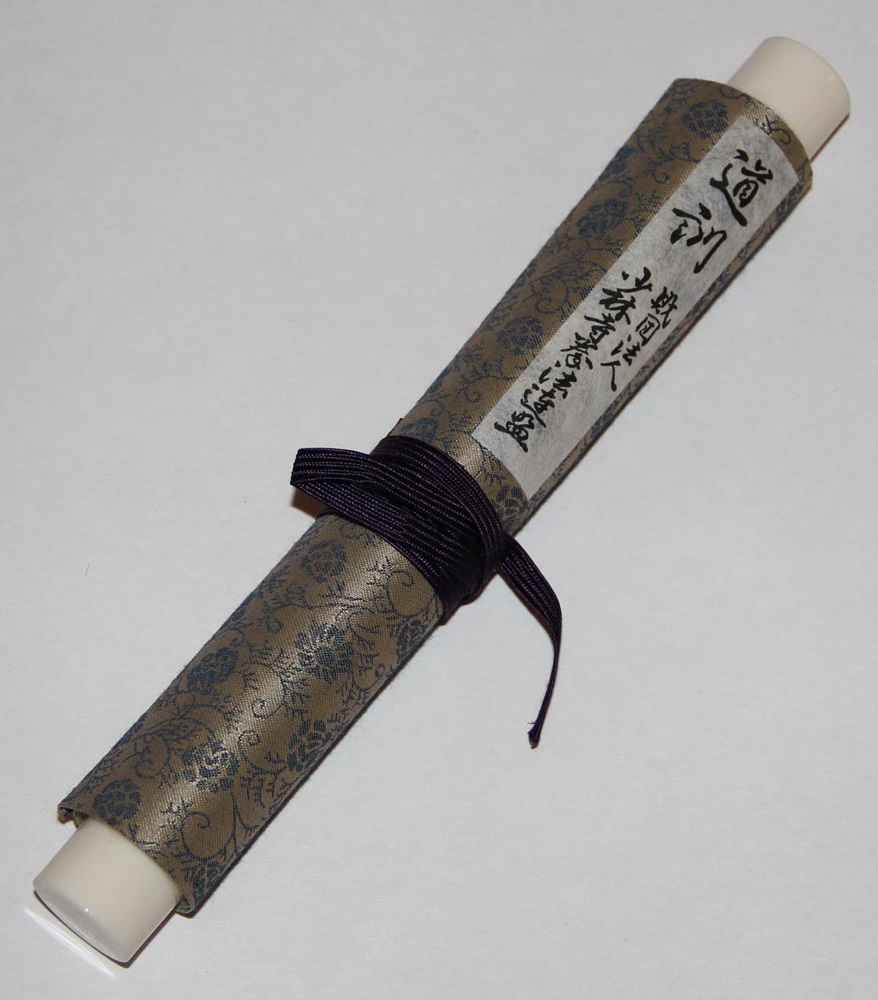Bassai-Dai Description
After bowing and announcing the name of the kata ("Bassai-Dai") ...
Yōi (cross open hands at groin level in
musubi dachi) and kiyomeri kokyū
(purification breaths)
Kamaete is not performed in
this kata.
| 1 | Close feet into heisoku dachi whilst turning hands thumb-side forward with left hand covering the knuckles of the right fist | |
| 2 | Lunge as far forward as possible into migi kōsa dachi(1) with kote-sasae yoko uke | |
| 3 | Turn 180 degrees left into hidari zenkutsu dachi with hidari yoko uke, then draw left foot back into hidari han-zenkutsu dachi with migi uchi kentsui uke | |
| 4 | Turn 180 degrees right into migi zenkutsu dachi with hidari uchi kentsui uke, then draw right foot back into migi han-zenkutsu dachi with migi yoko uke | |
| 5 | Step rearward with right foot, turning 90 degrees right into shiko dachi with migi sukui dome, drawing right foot inward into heikō dachi as the right arm rises to complete sukui dome | |
| 6 | Step forward into migi neko-ashi dachi with migi uchi kentsui uke, then hidari yoko uke | |
| 7 | Slide the right foot left in line with the left foot and turn 90 degrees left into heikō dachi with migi kote mageri | |
| 8 | Shift 45 degrees right into migi han-zenkutsu dachi with hidari yoko kentsui uchi to jōdan | |
| 9 | Shift 45 degrees left into heikō dachi with migi chūdan junzuki, then immediately shift 45 degrees left into hidari han-zenkutsu dachi with migi nagashi uke | |
| 10 | Shift 45 degrees right into heikō dachi with hidari chūdan junzuki, then immediately shift 45 degrees right into migi han-zenkutsu dachi with hidari nagashi uke | |
| 11 | Step 45 degrees left into migi neko-ashi dachi with migi gedan shutō barai uke | |
| 12 | Step forward into hidari neko-ashi dachi with hidari gedan shutō barai uke | |
| 13 | Step forward into migi neko-ashi dachi with migi gedan shutō barai uke | |
| 14 | Step backward into hidari neko-ashi dachi with hidari kakete uke | |
| 15 | Hidari katate kakete uke, then slide the left foot forward into hidari han-zenkutsu dachi with migi chūdan shotei uchi | |
| 16 | Maintaining hand positions from step #15 raise right knee and lunge forward with migi fumikomi geri with morote hikite(2) at left hip and kiai, finishing in migi han-zenkutsu dachi(3) | |
| 17 | Turn 180 degrees left into hidari neko-ashi dachi with hidari shutō uke | |
| 18 | Step forward into migi neko-ashi dachi with migi shutō uke | |
| 19 | Draw right foot back into heisoku dachi with jōdan wa uke | |
| 20 | Lean forward in wa uke, then lunge forward into migi han-zenkutsu dachi with morote gedan uchi kentsui uchi(4), and immediately slide the right foot forward and turn the body 90 degrees left into shiko dachi with migi chūdan yoko zuki | |
| 21 | Draw the left foot inward into heisoku dachi with migi-te ue manji uke (manji nage), looking to the left | |
| 22 | Step 90 degrees to the left into shiko dachi with simultaneous migi-te yoko gedan barai and hidari-te kagi zuki, then immediately pivot 180 degrees left and draw the left foot back into hidari han-zenkutsu dachi with hidari soto kentsui uchi to chūdan | |
| 23 | Open and turn the left hand into nukite position, migi-ashi mikazuki geri against the left palm, landing forward in migi han-zenkutsu dachi with migi chudan hiji ate against the left palm, immediately followed with hiji-sasae migi gedan barai, hiji-sasae hidari gedan barai, and hiji-sasae migi gedan barai in quick succession, then morote hikite at left side and hidari-te ue morote zuki | |
| 24 | Draw right foot back into heisoku dachi with morote hikite at right side, then step forward into hidari han-zenkutsu dachi with migi-te ue morote zuki | |
| 25 | Draw keft foot back into heisoku dachi with morote hikite at left side, then step forward into migi han-zenkutsu dachi with hidari-te ue morote zuki | |
| 26 | Pivoting on the right foot, turn 270 degrees left into hidari zenkutsu dachi with migi-te sukui-otoshi uke to right side | |
| 27 | Pivoting on both feet, turn 180 degrees right into migi zenkutsu dachi with hidari-te sukui-otoshi uke to left side | |
| 28 | Draw right foot inward and slightly back to face 45 degrees left in migi neko-ashi dachi with migi kakete uke(5) | |
| 29 | Slide right foot rearward with migi gedan shutō barai (both hands palm down), then pivot on both feet 90 degrees left into hidari neko-ashi dachi with hidari kakete uke(5) | |
| 30 | Pivoting on the right foot 45 degrees right, draw left foot back into heisoku dachi whilst turning hands thumb-side forward with left hand covering the knuckles of the right fist |
Zanshin yame is not performed in Bassai-Dai
Naotte
Rei


 As
with each new kata, it is important to remind
oneself of the adage: "Manabu no tame ni hyakkkai,
jukuren no tame ni senkai, satori no tame ni manga
okonau" (学ぶのために百回、熟練のために千回、悟りのために万回行う.).
A hundred times to learn, a thousand
times for proficiency, ten thousand
repetitions for complete understanding.
A related Okinawan saying is "ichi kata san nen"
(一型三年): one kata
three years. To become truly proficient-to be able to perform it
correctly, and with the speed, power, timing, and bushi damashii (samurai spirit) necessary
to make its techniques effective in a real self-defence
situation will take a thousand repetitions, which
equates to 100 days at ten repetitions a day.
And to fully understand and apply all of its principles,
nuances, and variations will take 1,000 days (three
years) at ten repetitions per day.
As
with each new kata, it is important to remind
oneself of the adage: "Manabu no tame ni hyakkkai,
jukuren no tame ni senkai, satori no tame ni manga
okonau" (学ぶのために百回、熟練のために千回、悟りのために万回行う.).
A hundred times to learn, a thousand
times for proficiency, ten thousand
repetitions for complete understanding.
A related Okinawan saying is "ichi kata san nen"
(一型三年): one kata
three years. To become truly proficient-to be able to perform it
correctly, and with the speed, power, timing, and bushi damashii (samurai spirit) necessary
to make its techniques effective in a real self-defence
situation will take a thousand repetitions, which
equates to 100 days at ten repetitions a day.
And to fully understand and apply all of its principles,
nuances, and variations will take 1,000 days (three
years) at ten repetitions per day.